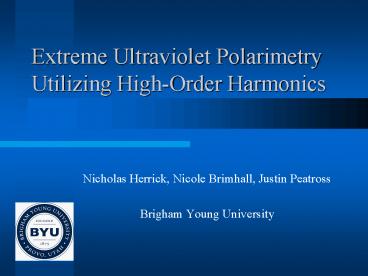Extreme Ultraviolet Polarimetry Utilizing High-Order Harmonics - PowerPoint PPT Presentation
1 / 23
Title:
Extreme Ultraviolet Polarimetry Utilizing High-Order Harmonics
Description:
Title: Controlled Attenuation of Laser High-Order Harmonics for Use in Extreme Ultraviolet Polarimetry Author: Office 2004 Test Drive User Last modified by – PowerPoint PPT presentation
Number of Views:76
Avg rating:3.0/5.0
Title: Extreme Ultraviolet Polarimetry Utilizing High-Order Harmonics
1
Extreme Ultraviolet Polarimetry Utilizing
High-Order Harmonics
- Nicholas Herrick, Nicole Brimhall, Justin
Peatross - Brigham Young University
2
Outline
- Introduction to extreme ultraviolet (EUV) optics
- Finding optical constants
- BYU Polarimeter
- High-intensity laser source
- High harmonic generation
- Polarimeter
- Controllable harmonic attenuation
- Results
3
Extreme Ultraviolet (EUV)
- 121 nm - 10 nm
4
Why Study EUV Optical Constants?
- Optical constants in the EUV range are largely
unknown or poorly characterized. - Because of this, designing EUV optics is
difficult. - Applications of EUV light
- computer chip lithography
- microscopy
- astronomy
Earths Plasmasphere at 30.4 nm. NASAs IMAGE
extreme ultraviolet imager
5
Finding Optical Constants
- Reflectance as a function of
- Angle
- Polarization
- Wavelength
6
Finding Optical Constants
- Reflectance as a function of
- Angle
- Polarization
- Wavelength
7
BYU Polarimetry
- The BYU polarimeter is a combination of three
optical systems
- High-intensity laser
- High harmonic generator
- Polarimeter
8
High-intensity Laser Source
- 800 nm, 30 x 10-15 sec pulse width
9
High Harmonic Generation
- A high intensity laser is focused into a cell
containing helium or neon. - Resultant EUV light ranges from 8 - 62 nm.
- Changes in laser linear polarization transfer to
resultant EUV polarization
10
BYU EUV Polarimeter
- Simultaneous measurements at multiple
wavelengths - Useable angles 0 - 40 from grazing
- Easily adjustable linear polarization
11
BYU EUV Polarimeter
12
EUV Controllable Attenuation
- By adjusting the voltage of the MCP, we can
detect over the entire range of reflectance - This is introduces and un-characterizable
variable and is unacceptable
- The dynamic range of our micro-channel plate
detector is insufficient to perform reflectance
measurements over the entire range of our
instrument.
Effective MCP dynamic range
13
EUV Controllable Attenuation
- Attenuation via secondary gas cell
- 14 cm long secondary gas cell is located
downstream from the primary harmonic generation
cell - Neon is added to the cell at pressures from 0 - 2
torr - Reduction of EUV flux during incident
measurements increases the dynamic range of our
detector - Using the absorption coefficient of neon the flux
is corrected
14
EUV Controllable Attenuation
- EUV light runs the full length of the secondary
gas cell. - Differential pumping chamber allows venting into
harmonic generation chamber.
Attenuator in harmonic generation chamber
15
EUV Controllable Attenuation
- Adjusting secondary gas cell pressure attenuates
flux so that it falls within the dynamic range of
the MCP
Pressure 1
Pressure 2
Pressure 3
Effective MCP dynamic range
16
Polarimetry Results
- Reflective measurements as low as 0.2
- Easily changeable linear polarization
- Wavelength range 8-62 nm
- High EUV flux (6 x 108 photons/sec at 100 eV)
- Positioning system accurate to 0.3 mm
Harmonics averaged in the y-direction.Data taken
at 10º from incidence.
17
Polarimetry Results
18
Summary
- We have constructed an EUV polarimeter utilizing
high-order harmonics as the light source. - The harmonic source has been shown to provide
ample flux for reflectance measurements through
50º from grazing. - Polarimeter reflectance data matches those taken
at the Advanced Light Source. - Characterization and use of the secondary gas
cell provides the necessary dynamic range for
reflectance measurements.
19
Future Research
- EUV H2O Transmission
- Direct characterization of H2O transmission
constants utilizing the secondary gas cell
CXRO Website
http//henke.lbl.gov/optical_constants/intro.html
20
Future Research
- EUV H2O Transmission
21
Future Research
- EUV H2O Transmission
- Two steps
- Hydrogen and Oxygen transmission constants
verification - Water vapor transmission characterization
- Comparison with CXRO data
- Further work in optical constants
- Examination of additional oxidized multilayer
mirrors - Other Experiments?
22
Acknowledgements
- Principle contributors
- Dr. Justin Peatross
- Nicole Brimhall
- Dr. David Allred
- The National Science Foundation
- The College of Physical and Mathematical
Sciences, BYU
23
(No Transcript)































